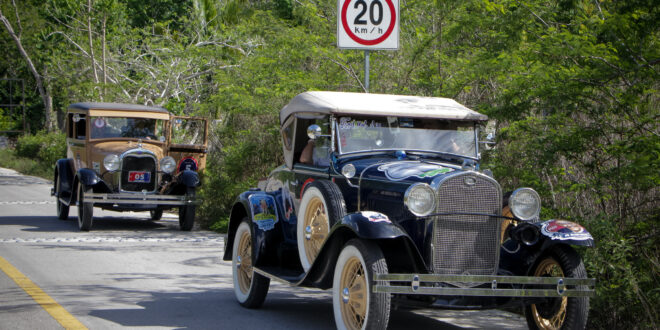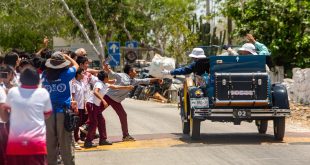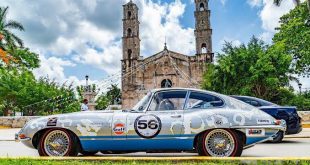El RMM engloba una serie de actividades y otras exclusivas amenidades para vivir una experiencia única en México.
El museo rodante es el Rally-tour de autos clásicos más galardonado de México.
110 tripulaciones disfrutan manejar autos clásicos mientras compiten en un ambiente seguro y controlado
Hasta el momento se han recorrido más de 8,600 kilómetros de la península de Yucatán.
Cancún, Quintana Roo, México 29 de abril 2022.- El Rally Maya México está a escasos días de arrancar la octava edición, los 110 vehículos que participarán en esta oportunidad de tener el placer de viajar en el tiempo preparan los últimos detalles para viajar hasta el sureste de la república mexicana para comenzar a enamorarse de los grandes atractivos que tanto Quintana Roo como Yucatán, tienen para compartir con el mundo y hoy continuaremos con ese recorrido por los sitios que serán testigos del museo rodante.
Uxmal u Óoxmáal (pronunciado [óːʃmáːl]) es una antigua ciudad maya del periodo clásico. Está localizado en el municipio de Santa Elena en el estado de Yucatán, México. En la actualidad es uno de los más importantes yacimientos arqueológicos de la cultura maya, junto con los de Chichén Itzá y Tikal. Se ubica en la llamada zona Puuc y es la ciudad más representativa de este estilo arquitectónico. Uxmal es considerada Patrimonio de la Humanidad por la UNESCO desde 1996.
Se localiza a 62 km al sur de Mérida, capital del estado de Yucatán en México. Sus edificaciones destacan por su tamaño y decoración. Entre ellas, así como entre otras ciudades de la zona, hay construidas unas calzadas llamadas sacbés.
Sus edificios son típicamente del estilo Puuc, con muros bajos lisos sobre los que se abren frisos muy ornamentados a base de representaciones de las cabañas típicas mayas, que se representan por columnillas (en representación de las cañas con las que se construían las paredes de chozas) y figuras trapezoidales (en representación de los tejados de paja), serpientes enlazadas y, en muchos casos bicéfalas, mascarones del dios de la lluvia, Chaac con sus grandes narices que representan los rayos de las tormentas, y serpientes emplumadas con las fauces abiertas saliendo de los mismos seres humanos. También se aprecia en algunas ciudades influencias de origen nahua y el seguimiento del culto a Quetzalcóatl y Tláloc que se integraron con las bases originales de la tradición Puuc.
Las construcciones aprovechan el relieve del terreno para ganar altura y adquieren volúmenes muy importantes, destacan la Pirámide del Adivino, con cinco niveles, y el Palacio del Gobernador que ocupa una extensión de más de 1.200m².
Santa Elena
Santa Elena, es una localidad del estado de Yucatán, México, cabecera del municipio homónimo ubicada aproximadamente 15 kilómetros al sureste del yacimiento arqueológico de Uxmal y a 110 kilómetros de la ciudad de Mérida, capital del estado.
Hay pruebas arqueológicas de que el sitio donde se ubica el pueblo de Santa Elena fue asiento, antes de la conquista de Yucatán, de un poblado indígena de maya.
Poco se sabe, sin embargo, de sus antiguos morados ya que a la llegada de los europeos en el siglo XVI el lugar y la zona habían sido abandonados. El sitio fue denominado en la época precolombina Nohcacab y perteneció al cacicazgo de Tutul Xiú.
Después de la conquista se estableció el régimen de las encomiendas y en el año de 1627 se tiene registrada la primera en ese lugar. Después de la independencia de Yucatán Santa Elena pasó a formar parte del Partido de Ticul. El pueblo de Santa Elena se erigió como cabecera del municipio homónimo en el año de 1918.
En Santa Elena hay un templo en honor de San Mateo, construido en el siglo XVII. En las cercanías se pueden apreciar vestigios arqueológicos de la cultura maya precolombina de gran importancia como Uxmal, Kabáh, Nohpat, Xcoh y Mulchic, correspondiendo todos ellos a la denominada región Puuc.
Ticul
Ticul es una ciudad ubicada en el estado mexicano de Yucatán, específicamente en el municipio homónimo que se encuentra en la Zona Sur Poniente o Región VIII del mismo estado.
Tiene una altura promedio de 25 m s. n. m. y se localiza a una distancia de 83 km de la ciudad capital del estado, la ciudad de Mérida. La ciudad es conocida como la Perla del Sur y destaca por su producción de calzado para dama y su alfarería.
El sitio en el que hoy se encuentra la ciudad de Ticul perteneció en tiempos prehispánicos al cacicazgo de Tutul Xiú. No se ha podido determinar la fecha exacta de su fundación por parte de los españoles, pero en el año de 1549 ya se había establecido una encomienda.
Declarada la independencia de Yucatán y su posterior anexión al resto de la república, el entonces pueblo de Ticul pasa a formar parte del Partido de la Sierra Alta, teniendo como cabecera a Tekax.
Debido a diversos cambios en la división política de la península durante el siglo XIX. Ticul se erige en cabecera del partido de su mismo nombre. En este mismo siglo, adquiere en 1847 el título de Villa y en 1960 mediante un decreto de la VII legislatura del estado, se añade a la entonces villa de Ticul el apellido del ilustre coronel Alberto Morales por lo que a partir de esa fecha se empezó a llamar “Ticul de Morales”.
Pustunich
Pustunich es una localidad ubicada en el estado mexicano de Yucatán, en el municipio de Ticul que se encuentra en la zona sur poniente o Región VIII del mismo estado. Se localiza a una distancia de 86 km de la ciudad capital del estado, la ciudad de Mérida, a 3 km al sureste de Ticul.
El significado de la palabra Pustunich en Idioma maya es piedra encorvada por derivar de los vocablos Pus, jorobado y Tunich, piedra. El sitio en el que hoy se encuentra Pustunich perteneció en tiempos prehispánicos al cacicazgo maya de los Tutul Xiúes.
Declarada la independencia de Yucatán y su posterior anexión al resto de la república, el pueblo de Pustunich formó parte del Partido de la Sierra Alta, teniendo como cabecera a Tekax.
Yotholin
La localidad de Yotholín está situada en el Municipio de Ticul (en el Estado de Yucatán). Hay poco más de 2,500 habitantes y un porcentaje del 88% de población indígena. El pueblo de Yotholín está situado a 11.2 kilómetros de Ticul, que es la localidad más poblada del municipio, en dirección Noreste.
Sus principales atractivos con el que cuenta Yotholín son: la iglesia de San Juan Buenaventura (Siglo XVIII) con más de 80 años de historia en todos y cada uno de sus muros, las Grutas Yaxnic “Cuevas de Cristal” ocupan el primer lugar en Yucatán en cuanto a belleza por sus formaciones naturales y el museo comunitario Ya´ax Nic (que significa hojas muy verdes caídas o amontonadas) con la finalidad de preservar la cultura, ya que alberga numerosas piezas antiguas.
ACERCA DEL RALLY MAYA MÉXICO
El Rally Maya conocido también por ser un “museo sobre ruedas” entre los amantes de los autos, se quiere mostrar como una oportunidad única de conocer la riqueza natural, cultural, gastronómica y arqueológica del mundo maya. Durante la competencia más de 100 tripulaciones, procedentes de México, Europa, Centroamérica y Sudamérica realizarán tránsitos y regularidades, probando la habilidad del piloto y copiloto para mantener con toda precisión las velocidades preestablecidas en un tiempo determinado.
Para esta competencia los automóviles deben tener más de 40 años de antigüedad y tener un 90 por ciento de originalidad para poder participar dentro de una de las tres categorías de antigüedad: vehículos fabricados de 1915 a 1949 en la categoría “A”, para la categoría “B” los autos de 1950 a 1969 y de 1970 a 1980 en la categoría “C”.
PRESS RELEASE ENGLISH VERSION
NOMINADOS ENTRE LOS MEJORES
The RMM encompasses a series of activities and other exclusive amenities for a unique experience in Mexico.
The rolling museum is the most awarded classic car rally-tour in Mexico.
110 crews enjoy driving classic cars while competing in a safe and controlled environment.
More than 8,600 kilometers of the Yucatan Peninsula have been covered so far.
Cancun, Quintana Roo, Mexico (Monday, April 11, 2022) – Rally Maya Mexico is just days away from starting its eighth edition, the 110 vehicles that will participate in this opportunity to have the pleasure of traveling through time are preparing the last details to travel to the southeast of the Mexican Republic to begin to fall in love with the great attractions that both Quintana Roo and Yucatan have to share with the world and today we will continue with this tour of the sites that will witness the rolling museum.
Uxmal
Uxmal or Óoxmáal (pronounced [óːʃmáːl]) is an ancient Maya city of the Classic period. It is located in the municipality of Santa Elena in the state of Yucatan, Mexico. It is currently one of the most important archaeological sites of the Mayan culture, along with those of Chichén Itzá and Tikal. It is located in the Puuc zone and is the most representative city of this architectural style. Uxmal is considered a World Heritage Site by UNESCO since 1996.
It is located 62 km south of Merida, capital of the state of Yucatan in Mexico. Its buildings stand out for their size and decoration. Among them, as well as among other cities in the area, there are built roads called sacbes.
Its buildings are typically of the Puuc style, with smooth low walls on which friezes open, highly ornamented with representations of the typical Mayan huts, represented by small columns (representing the reeds with which the walls of the huts were built) and trapezoidal figures (representing the thatched roofs), snakes entwined and, in many cases bicephalous, masks of the god of rain, Chaac with their big noses that represent the thunderbolts of the storms, and feathered snakes with open jaws coming out of the same human beings. Some cities also show influences of Nahua origin and the cult of Quetzalcoatl and Tlaloc that were integrated with the original bases of the Puuc tradition.
The constructions take advantage of the relief of the terrain to gain height and acquire very important volumes, the Pyramid of the Soothsayer, with five levels, and the Governor’s Palace that occupies an extension of more than 1,200m² stand out.
Santa Elena
Santa Elena, is a town in the state of Yucatan, Mexico, head of the municipality of the same name located approximately 15 kilometers southeast of the archaeological site of Uxmal and 110 kilometers from the city of Merida, capital of the state.
There is archaeological evidence that the site where the town of Santa Elena is located was the seat, before the conquest of Yucatan, of an indigenous Maya settlement.
Little is known, however, of its ancient dwellings, since the place and the area had been abandoned by the arrival of the Europeans in the 16th century. The site was called Nohcacab in pre-Columbian times and belonged to the Tutul Xiú chiefdom.
After the conquest, the encomienda regime was established and in 1627 the first encomienda was registered in this place. After the independence of Yucatan, Santa Elena became part of the Partido de Ticul. The town of Santa Elena was established as the head of the municipality of the same name in 1918.
In Santa Elena there is a temple in honor of San Mateo, built in the 17th century.
Nearby you can appreciate archaeological vestiges of the pre-Columbian Mayan culture of great importance such as Uxmal, Kabáh, Nohpat, Xcoh and Mulchic, all of them belonging to the Puuc region.
Ticul
Ticul is a city located in the Mexican state of Yucatan, specifically in the municipality of the same name, which is located in the Zona Sur Poniente or Region VIII of the state of Yucatan.
It has an average altitude of 25 m a.s.l. and is located at a distance of 83 km from the capital city of the state, the city of Merida. The city is known as the Pearl of the South and stands out for its production of women’s footwear and pottery.
The site where the city of Ticul is located today belonged in pre-Hispanic times to the chiefdom of Tutul Xiú. It has not been possible to determine the exact date of its foundation by the Spaniards, but in the year 1549 an encomienda had already been established.
Once the independence of Yucatan was declared and its subsequent annexation to the rest of the republic, the then town of Ticul became part of the Partido de la Sierra Alta, with Tekax as its head town.
Due to various changes in the political division of the peninsula during the 19th century. Ticul became the head of the partido of the same name. In this same century, in 1847 it acquired the title of Villa and in 1960, by means of a decree of the VII state legislature, the surname of the illustrious Colonel Alberto Morales was added to the then town of Ticul, so that from that date onwards it began to be called “Ticul de Morales”.
Pustunich
Pustunich is a locality located in the Mexican state of Yucatan, in the municipality of Ticul, in the south-western zone or Region VIII of the state. It is located at a distance of 86 km from the capital city of the state, the city of Merida, 3 km southeast of Ticul.
The meaning of the word Pustunich in the Mayan language is bent stone, derived from the words Pus, humpbacked, and Tunich, stone. The site where Pustunich is located today belonged in pre-Hispanic times to the Mayan chiefdom of the Tutul Xiúes.
Once the independence of Yucatan was declared and its subsequent annexation to the rest of the republic, the town of Pustunich became part of the Partido de la Sierra Alta, with Tekax as its head town.
Yotholin
The town of Yotholin is located in the Municipality of Ticul (in the State of Yucatan). There are just over 2,500 inhabitants and 88% of the population is indigenous. The town of Yotholín is located 11.2 kilometres from Ticul, which is the most populated locality of the municipality, in a northeasterly direction.
The main attractions of Yotholín are: the church of San Juan Buenaventura (XVIII century) with more than 80 years of history in each and every one of its walls, the Yaxnic Caves “Cuevas de Cristal” (Crystal Caves), which occupy the first place in Yucatan in terms of beauty due to their natural formations, and the community museum Ya’ax Nic (which means very green fallen or piled leaves) with the purpose of preserving the culture, since it houses numerous ancient pieces.
ABOUT RALLY MAYA MEXICO
The Rally Maya México, also known as a “museum on wheels” among car lovers, is a unique opportunity to get to know the natural, cultural, gastronomic and archaeological richness of the Mayan world. During the competition, more than 100 crews from Mexico, Europe, Central and South America will perform transits and regularities, testing the ability of the driver and co-driver to accurately maintain the pre-established speeds in a given time.
For this competition, cars must be more than 40 years old and have 90 percent originality in order to participate in one of the three age categories: vehicles manufactured from 1915 to 1949 in category “A”, for category “B” cars from 1950 to 1969 and from 1970 to 1980 in category “C”.
 www.yucatanalinstante.com Noticias al Instante
www.yucatanalinstante.com Noticias al Instante




